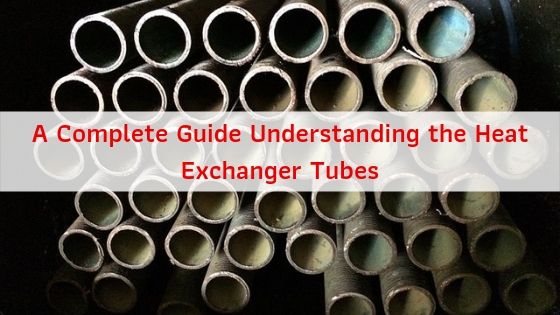Quick Inquiry
The technology used in heat exchanger tubes is very old involving different methods of heat transfer such as radiation, convection, and conduction.
Heat exchanger tube is a device which is used to transfer heat from one medium to another for both cooling and heating processes. It separates the medium which is being used. Heat is transferred through these exchanger tubes by the conduction process. Mediums can be liquid, vapor, or gas. For example, an air-cooled heat exchanger uses air to cool a liquid and a shell & tube heat exchanger is for passing fluids.
The term ‘heat exchanger’ is mostly used when we refer to tube hear exchangers and plate heat exchangers. Refrigerators, chemical plants, air conditioners, power stations, etc. use the heat exchanging process. At times, the overall energy efficiency of a plant can be determined by these tubes. This article focuses on everything you need to know about heat exchanger tubes including the different types of tubes and their applications.

Heat Exchanger Pass
The movement of the fluid through the heat exchanger tubes is known as heat exchanger pass. Single pass is when the fluid enters from one end and exits from the other end of the heat exchanger tube. Double pass allows the fluid to enter and exit from the same end. In triple pass, the fluid passes the heat exchanger tube three times before it finally exits.
Types of Heat Exchanger Tubes & Their Characteristics
The selection of a particular heat exchanger tube depends on the rate of heat transfer. Moreover, the required heat load and temperature signify the size of the heat exchanger tubes. These can be manufactured in U-Bent shapes or Straight Lengths based on the requirements. It is interesting to know that the basic configuration of heat exchangers remain the same irrespective of their different sizes and complexities.
Based on their design characteristics, heat exchangers and their applications are classified. These characteristics define the efficiency of the tubes including some factors.
Classification Based On Flow Configuration
The movement of the flow of the fluid is also considered in heat exchanger tubes. There are four main flow configurations – 1. Parallel flow, where the fluids move in the same direction. 2. Counter flow, here the fluids move in opposite directions. This is more efficient than the parallel flow heat exchanger. 3. Cross flow, this allows the fluid to move perpendicular to each other. 4. Hybrid flow, here multiple flow passes can take place.
The rate in which the fluid flows in the exchanger tubes matters a lot. This is known as the flow rate. The capacity of heat exchanger to transfer heat increases with the increase in the flow rate. However, this also increases the mass and velocity, reducing the pressure ultimately making it a challenge to remove the energy.
Classification Based On Heat Transfer Mechanism
Heat exchanger tubes have two types of heat transfer mechanisms – single phase or two phase. There is no phase change in the first type of heat transfer process. In simple words, fluids continue to remain in the same state as they enter the heat exchanger tube. The latter type is opposite to this. It allows the fluids to change their state during the heat transfer process. Therefore, based on heat transfer mechanism, heat exchangers can be classified into four types:
- Single phase convection on both sides
- Single phase on one side and two-phase on the other side
- Two phase convention on both sides
- Radiative & combined convection heat transfer
Classification Based On Construction Method
Based on their construction methods heat exchanger tubes can be classified as the following:
Capacitive heat exchangers – Here, warm and cool fluids flow through the same channel alternately. These are basically of two types – static & dynamic heat exchangers. In the former, the heat exchanger components remain static during the flow while in the latter, the components move throughout the process.
Recuperative heat exchangers – Here, each fluid flows through its own channel simultaneously. These are basically of two types – Direct & indirect contact heat exchangers. In the former, heat transfers from one fluid to another with direct contact (fluids are not separated inside the tube), whereas, in the latter fluids flow separate inside the tube.
Components & materials used – This depends on the type of the heat exchanger and its application. Some common ones are tubes, shells, plates, fins, spiral tubes, etc.
Factors to consider while selecting a heat exchanger:
- Primary & secondary circuit liquid types
- Temperature and flow rates of both
- What is the purpose of the primary circuit
To name a few heat exchanger tubes, we have shell and tube heat exchanger, plate heat exchanger, plate and shell heat exchanger, plate fin heat exchanger, etc.
Application of Heat Exchangers
These heat exchanger tubes are mostly used in power plants, chemical factories, ship buildings, fertilizer plants, refineries, steel plants, etc. Their application is usually in high pressure equipment, air pre heaters, air coolers, pressure vessels, heat exchanger tube sheets, boilers, cryogenic pressure vessels, finned tubes, etc.
Increase The Life Span of a Heat Exchanger
There are certain ways which can help increase the life time of a heat exchanger. The design data has to be accurate. It will enhance the thermal efficiency and also increase the life of the heat exchanger. Another point to consider is the filling and pipe work. Moreover, with regular maintenance and service life span of the heat exchangers can increase.
The thermal energy required for heating or cooling a liquid is also provided by the heat exchangers.
Anand Seamless Ltd is a leading heat exchanger manufacturer. We have the expertise and resources to produce and supply premium quality seamless tubes.
For more information about our products, please call us at +91-9099996851. We’ll be happy to assist you!
lATEST BLOG |
|
Why Are SA 179 Tubes a Popular Choice for Marine Applications?
SA 179 tubes are an integral part of the marine in |
|
Introductory Guide to Hydraulic Tubes
Hydraulic systems are integral to many industries, |
|
Essential Factors That Influence Finned Tube Pricing
Finned tubes are crucial components in many indust |
|
How to Select the Right SA 179 Seamless Tube For Your Project?
Choosing the right SA 179 seamless tube for your p |
|
An Introductory Guide to Understanding Evaporator Tubes
Evaporator tubes are crucial components in various |

